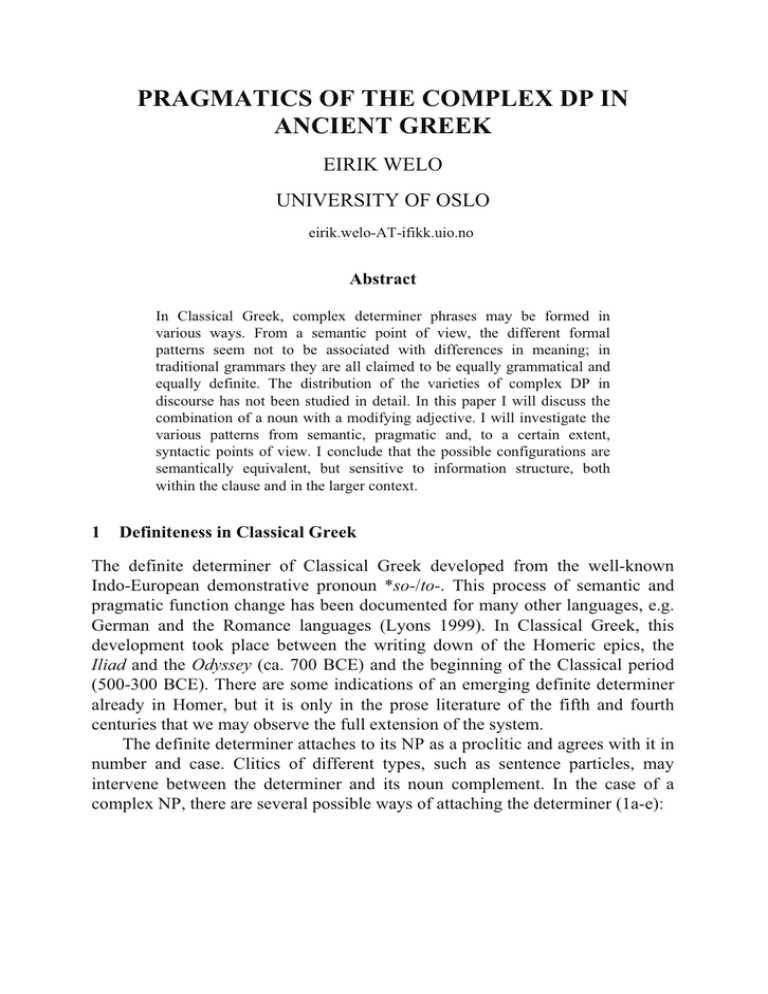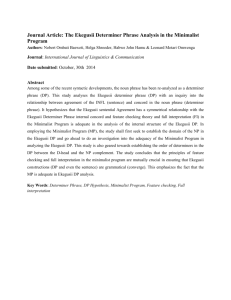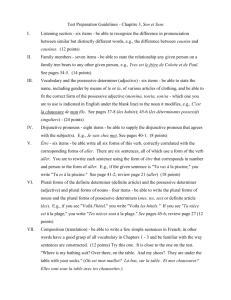PRAGMATICS OF THE COMPLEX DP IN ANCIENT GREEK EIRIK WELO UNIVERSITY OF OSLO
advertisement

PRAGMATICS OF THE COMPLEX DP IN ANCIENT GREEK EIRIK WELO UNIVERSITY OF OSLO eirik.welo-AT-ifikk.uio.no Abstract In Classical Greek, complex determiner phrases may be formed in various ways. From a semantic point of view, the different formal patterns seem not to be associated with differences in meaning; in traditional grammars they are all claimed to be equally grammatical and equally definite. The distribution of the varieties of complex DP in discourse has not been studied in detail. In this paper I will discuss the combination of a noun with a modifying adjective. I will investigate the various patterns from semantic, pragmatic and, to a certain extent, syntactic points of view. I conclude that the possible configurations are semantically equivalent, but sensitive to information structure, both within the clause and in the larger context. 1 Definiteness in Classical Greek The definite determiner of Classical Greek developed from the well-known Indo-European demonstrative pronoun *so-/to-. This process of semantic and pragmatic function change has been documented for many other languages, e.g. German and the Romance languages (Lyons 1999). In Classical Greek, this development took place between the writing down of the Homeric epics, the Iliad and the Odyssey (ca. 700 BCE) and the beginning of the Classical period (500-300 BCE). There are some indications of an emerging definite determiner already in Homer, but it is only in the prose literature of the fifth and fourth centuries that we may observe the full extension of the system. The definite determiner attaches to its NP as a proclitic and agrees with it in number and case. Clitics of different types, such as sentence particles, may intervene between the determiner and its noun complement. In the case of a complex NP, there are several possible ways of attaching the determiner (1a-e): Eirik Welo (1) a. b. c. d. e. ho agathos anêr (Determiner-Adjective-Noun = DAN) ‘The good man’ ho anêr ho agathos (DNDA) anêr ho agathos (NDA) agathos ho anêr (ADN) ho anêr agathos (DNA) The patterns documented in (1) are divided by traditional school grammar into two main groups. In (1a-c), the adjective is said to stand in an attributive relation to the noun, while in (1d-e), it is said to be used predicatively.1 In the following discussion we will be concerned with the first three patterns, and more specifically with (1c). It should be noted at the outset that while (1c) may give the impression of being more intimately related to (1a), the only difference being whether the noun precedes or follows the determiner-adjective complex, the expected variant of (1b), *ho agathos ho anêr (DADN) is not found in Classical Greek texts. 2 Pragmatic roles and information structure Since we are interested in the possible differences in pragmatic function between the various configurations of the complex DP in Greek, we must outline a model of information structure. We claim, following KruijffKorbayová and Steedman (2003), that information structure is best understood by assuming that it consists of two interacting parameters, viz. theme-rheme (or topic-comment) and focus-presupposition. The parameters interact in the following manner (Kruijff-Korbayová and Steedman 2003: 251): (2) [Theme ][Rheme ] [[Focus] [Presupposition ][Focus] [Presupposition ]] According to (2), both theme and rheme may contain focussed elements. Because of a more general principle of informativity, the rheme must contain a focussed element. When the theme contains a focus as well, the result is a contrastive theme (cf. also Büring 2003). When the focus is co-extensive with the rheme, we have ‘broad’ or ‘informational’ focus. When the focus domain is smaller than the rheme domain, we have ‘narrow’ focus. Following Rooth’s (1992) alternative semantics account of focus interpretation, we derive the meaning nuances associated with focus expressions 1 The term ‘predicatively’ as used within Classical Philology includes both primary and secondary predication: ho anêr agathos ‘the man is good’, a complete sentence, vs. ho anêr agathos ‘the man, if/since/when he is good…’, a sentence fragment requiring a finite verb. 188 Pragmatics of the Complex DP in Ancient Greek (‘counter-assertive focus’, ‘exhaustive listing focus’, etc.) from the interaction of the focus expression with the larger context.2 The definition of theme and rheme is a more tricky business. It seems clear that in order to function as theme, a linguistic expression must refer to a specific, already established discourse referent (cf. Karttunen 1976 for discourse referents). Whether it must also refer uniquely to this referent, is not quite clear (cf. Dyvik 1979 on the referential properties of NPs in Old Norse and Modern Norwegian and Kiss 2002: 11 on specific indefinite topics in Hungarian). In general, specific indefinites may not replace definite NPs or anaphoric pronouns, cf. ‘I saw a dog yesterday. It/the dog/*a dog tried to bite me.’ Below, we will approach the main question of the paper by a somewhat circuitous route. First, we will take a look at the use of the definite article with proper names in an attempt to separate the pragmatic use of the determiner from its semantic core meaning. After that, we will return to the question of the semantics and pragmatics of complex DPs. 3 The definite determiner with proper names A clear example of a pragmatic use of the definite determiner in Classical Greek is its use with proper names.3 If proper names are taken to refer to unique individuals, they must by definition always be definite from a semantic point of view. Hence, the determiner would seem to be superfluous. In a context which involves several people who have the same name, the semantic interpretation of the definite determiner as denoting a uniquely identifiable referent, would predict that it should in fact be disallowed. Consequently, the function of the determiner with proper names cannot be to identify a referent for the name to the exclusion of other possible candidates. Alternatively, we may take the determiner to indicate that the person referred to with the name is already established as a discourse referent. The meaning of the name ho Kuros would then be something along the lines of ‘the aforementioned Kyros’. This does not seem, however, to be the case generally, cf. example (3):4 2 We believe this to be basically right, although languages may grammaticalize focus variants in various ways, cf. e.g. É Kiss (1998). 3 In contrast to the usage in Modern Greek, where the determiner is obligatory with proper names (Lyons 1999:121, Holton et al. 2002:278), such names often occur without a determiner in Classical Greek texts. Cf. also the paper by Janne Bondi Johannessen in this volume. 4 In the Greek examples the following abbreviations are used: The cases are nominative (N), accusative (A), genitive (G) and dative (D); the numbers are singular (SG) and plural (PL); the tenses are present (PR), imperfect (IM), aorist (AO) and future (FUT). Relative pronouns are glossed as REL, infinitives as INF and, finally, particles as PART. I have glossed participles with English participle forms, although they do not match in every detail. For proper names, I only note the case, not the number, which is in all cases singular. 189 Eirik Welo (3) Dareiou kai Parusatidos gignontai paides duo, presbuteros men Dar-G and Par-G become-PR3PL children-NPL two, older-NSG PART Artaxerxes, neôteres de Kuros. … epei de eteleutêse Dareios kai Art-N younger-NSG PART Kur-N…when PART die-AO3SG Dar-N and katestê eis tên basileian Artaxerxes… establish-AO3SG to the kingdom Art-N ‘Darius and Parysatis had two sons born to them, of whom the elder was Artaxerxes and the younger Cyrus. … When Darius had died and Artaxerxes had become established as a king...’ (Xenophon, Anabasis I.1.1-3, trans. Brownson/Dillery) The first sentence introduces the king of Persia, Darius, his queen and their two sons. In the temporal clause which follows shortly after the names of the king and his eldest son are not provided with a definite determiner even though the first sentence clearly establishes them as discourse referents. Now compare the following example, from the same context: (4) Tissaphernes diaballei ton Kuron pros ton adelphon hôs Tis-N attack-PR3SG the Kur-N to the brother-ASG that epibouleuei autôi plot-PR3SG him-DSG ‘Tissaphernes falsely accused Kyros to his brother of plotting against him.’ (Xenophon, Anabasis I.1.3, trans. Brownson/Dillery) Here the name Cyrus occurs with the definite determiner, while Tissaphernes, who was introduced as the end of the preceding paragraph, does not. Does the determiner then indicate some kind of contrast, e.g. between Cyrus and his brother? The following example contains a pair of contrastive topics which show this not to be the case: (5) ho men oun presbuteros parôn etugkhane. Kuron the PART PART elder-NSG being-present-NSG happen-IM3SG. Kur-ASG de metapempetai apo tês arkhês hês auton satrapên PART summon-PR3SG from the province REL-G him satrap epoiêse. make-AO3SG ‘The elder, as it chanced, was with him already; but Cyrus he summoned from the province over which he had made him satrap.’ (Xenophon, Anabasis I.1.2, trans. Brownson/Dillery) 190 Pragmatics of the Complex DP in Ancient Greek Here there is an explicit contrast between Artaxerxes, the elder brother, and Cyrus. As we have seen, Cyrus has already been established as a discourse referent, but neither this fact nor the contrast is apparently enough to make the determiner obligatory. The determiner frequently, though not universally, occurs with proper names when there is a shift of grammatical subject: (6) en Milêtôi de Tissaphernes proaisthomenos ta auta tauta in Mil-DSG PART Tis-NSG finding-out-before-NSG the same those bouleuomenous apostênai pros Kuron, tous men autôn apekteine, plan-APL desert-INF to Kur-N, some PART of-them kill-AO3SG, tous d’ exebalen. some PART expel-AO3SG Ho de Kuros hupolabôn tous pheugontas sullexas strateuma the PART Kur-N protecting-NSG the fleeing-APL collecting-NSG army epoliorkei Milêton… besiege-IM3SG Mil-ASG ‘The people of Miletus also were planning to do the very same thing, namely, to go over to Cyrus, but Tissaphernes, finding out about it in time, put some of them to death and banished others. Cyrus thereupon took the exiles under his protection, collected an army, and laid siege to Miletus…’ (Xenophon, Anabasis I.1.7, trans. Brownson/Dillery) In this example, the transition from Tissaphernes to Cyrus as grammatical subject/sentence topic is accompanied by the occurrence of the determiner on the new subject. This is, however, not always the case, and the name which receives the determiner is frequently not the grammatical subject. In example (4) given above, Cyrus is the direct object of the verb diaballein ‘falsely accuse’, and the object stays in postverbal position. Accordingly, it is difficult to construe it as the theme, which usually comes first in the sentence. The same goes for the following example: (7) Parusatis men dê hê meter hupêrkhe tôi Kurôi… Par-N PART PART the mother-NSG support-IM3SG the Kur-D ‘Parysatis, his mother, supported Cyrus’ (Xenophon, Anabasis I.1.4, my translation) 191 Eirik Welo Here Cyrus’s mother, Parysatis, is the subject, while Cyrus again occurs postverbally. Interestingly, Brownson/Dillery in their translation make Cyrus the topic as well as the subject: ‘He had …the support of Parysatis, his mother…’ Hence we may perhaps take the function of the determiner here to be to indicate the discourse topic: Cyrus’ plans to revolt against his brother are the subject of the paragraph which example (7) is taken from, and Cyrus is the subject of the sentences which precede and follow the example sentence. The main participants in this story are the brothers Artaxerxes and Cyrus. Perhaps the determiner is used with his name to indicate that while Parysatis is the grammatical subject of the sentence, Cyrus is the underlying theme. Consequently, the main point of example (7) is not that Parysatis supported her son Cyrus, but that he received the support of his mother. As we have seen, it is difficult to draw general conclusions about the function of the definite determiner with proper names. We might follow Dyvik’s (1979) lead and assume that for proper names in Classical Greek, non-use of the determiner is the unmarked option, in contrast to Modern Greek. It may also be that the determiner indicates the discourse topic. Is it possible to identify a comparable effect with complex DPs? More specifically, does the difference between the two patterns DNDA and NDA boil down to a difference with regard to informational status in the discourse? I will return to this problem in section 7 below. 4 The scope of the definite determiner In complex DPs in English, the determiner has scope over the entire NP. This is clearly seen in examples like ‘the black cat’, ‘the tiny, old woman’, etc. From a semantic point of view, the noun and the adjective are put together first, and then the determiner is applied to the NP ‘black cat’ as a whole. Alternative orders of composition produce ungrammatical results as ‘a cat the black’, ‘the cat black’, etc. As shown above, there exist several possible orders for complex DPs in Greek. The one resembling the English pattern most closely is the order Determiner-Adjective-Noun (DAN). Because of the superficial similarity of these patterns in the two languages, we tend to interpret the Greek DP as equivalent to the English one in its semantics as well as in linearity. That is, we quietly assume that the determiner in Greek projects definiteness over the entire NP. This assumption is problematic for two reasons. The first concerns the possibility of marking definiteness explicitly for the whole NP. As we have seen in example (1), postnominal attributive adjectives must be marked for definiteness separately from their nouns: ho anêr ho agathos ‘the good man’. This fact seems to indicate that the scope of the determiner goes no further than 192 Pragmatics of the Complex DP in Ancient Greek to the noun and has to be extended by the introduction of another determiner. This is in fact the case for every additional postnominal adjective: the determiner must be repeated for each one. Secondly, if the pattern NDA anêr ho agathos is interpreted as equivalent to its English translation ‘the good man’, then the determiner must project its definiteness upwards from the adjective to scope over the noun as well.5 5 Semantics of the definite determiner with complex NPs The following discussion of the various patterns of complex DPs consisting of a noun and a modifying adjective will concern the configurations (1a-c) as exemplified above. My explanation is couched in terms of a compositional semantics for the complex DPs and on general considerations of economy in the marking of dependencies within the DP. In an intensional semantics, adjectives are taken to denote functions which map properties onto referents which have the relevant properties. Thus ‘red’ denotes a function which, when applied to an argument, gives as its value a referent which has the property ‘red’, as e.g. ‘red car’. (With an intersective adjective like ‘red’, we could use an extensional semantics without running into trouble. The above formulation would then be equivalent to saying that ‘red car’ denotes the intersection of the sets denoted by ‘red’ and ‘car’.) The definite determiner, on the other hand, denotes a function which maps its argument onto the singleton set containing the only referent which has the relevant property. In the case of a complex property like ‘red car’, ‘the red car’ denotes the intersection of ‘red’ and ‘car’ only if it contains exactly one member. Let us try on the basis of these definitions of the semantics of the parts to analyse the composition of the various orders of the complex DP in Greek. We will begin with the configuration which resembles English most closely, viz. DAN ho agathos anêr ‘the good man’. We start by applying the function agathos to its argument anêr. This gives us the common NP ‘good man’ which as mentioned above denotes a function. We let this function be the argument of the definite determiner ho (formally nominative masculine singular). As in our English example ‘the red car’, we end up with the DP ‘the good man’. For a proposition containing this phrase to be true, it is at least necessary that there is only one referent which is both a man and good in the relevant model. If we move on to the configuration DNDA, we first apply the adjective to the determiner. For ‘the good man’ this means that we apply ‘good’ to ‘the’. An expression such as ‘the good’ is ambiguous in Greek. On the one hand, it may 5 I will not attempt a syntactic explanation for this here, but cf. the discussion of this pattern in section 7 below. 193 Eirik Welo mean that the property denoted by the adjective picks out a set which has only one member. On the other, the adjective may be taken as a null head modifier as noted by Devine and Stephens (2000: 228ff.). In this sense, the adjective picks out a contextually given referent which has the property in question. The adjective introduces a variable which is bound by any referent which satisfies the conditions inherent in the semantics of the adjective. In our case, the binding takes place at the next stage of composition, namely, when the function ‘the good (one)’ is applied to the argument ‘man’. We now have ‘man the good (one)’. The function picks out the intersection between the set denoted by ‘good’, a contextually given referent and the set denoted by ‘man’ on the condition that this set is a singleton set. At this point, we have actually derived the semantics of the configuration NDA as well. The meaning of NDA anêr ho agathos is thus shown to be identical to the meaning of DAN ho agathos anêr. They both denote the single referent which is both a man and good. In this situation it seems superfluous to apply the determiner to ‘the good man’ once more. We have derived the attested orders for the combination of an attributive adjective and a noun. We will not pursue the discussion of why the historical development of a definite determiner led to exactly these configurations. This is a complicated question, which deserves a more detailed account than we are able to give at this point. 6 Syntax or pragmatics We have determined that the semantics of the various attested orders within the DP does not allow us to distinguish between them in a principled way. The question remains whether the reason for the variety is to be found in syntax or pragmatics. We will discuss pragmatics first and then evaluate the consequences for the syntax. Dik (1997) discusses the placement of modifying adjectives in relation to their nouns. She explains the various attested patterns in terms of focus. Dik concludes that an adjective appears after the noun when the adjective is not ‘contrastive or otherwise the most salient element in a noun phrase’ (1997: 76). When it is contrastive, it will appear before the noun. While she does not provide a formal analysis of the Greek noun phrase, her conclusion is compatible with a movement analysis along the lines of Devine and Stephens (2000). Her concluding statement may be reformulated as a claim that adjectives are base-generated in postnominal position. When focused, the adjective must move to a phrase internal focus position. The same applies to nouns: focused nouns move to the same phrase internal focus position. This last movement operation would, however, be string vacuous since the noun precedes the adjective in the first place and doesn’t move beyond the DP. 194 Pragmatics of the Complex DP in Ancient Greek Examples from Greek show that the complex DP configuration NDA frequently must be given a definite reading. If we combine this fact with the semantic analysis above which showed that the first determiner in the configuration is superfluous from a semantic point of view, it is tempting to hypothesize that it plays a pragmatic role. This role may be identical to the role which the definite determiner plays with proper names; in other words, the first determiner in the DNDA complex indicates the role of the DP as a whole in discourse structure. If this is the case, then why isn’t an extra determiner inserted in front of the noun in the DAN configuration? One reason may be that the ‘pragmatic’ determiner is always placed at the left edge of the DP as a whole. Since the DP does already have a determiner at its left edge, there is no need for a second one. Alternatively, we might appeal to a morpho-phonological rule which deletes one of two identical determiners.6 7 The pragmatic function of (D)NDA So far our examination of complex DPs has shown that the first determiner in the DNDA configuration does not contribute to the semantics of its phrase. Rather its role is to indicate the status of the DP in discourse structure. It is not possible to give explicit expression to this distinction with DPs of type DAN. In this section we will discuss the discourse structural role of (D)NDA and give some examples of its use.7 Devine and Stephens cite the following example from Herodotus in order to illustrate his use of split constituents, but it is interesting as an example of NDA order as well: (8) epiphaneos de toutou genomenou autika hoi Aigyptioi visible-GSG PART he-GSG becoming-GSG at-once the Egyptian-NPL heimata te ephoreon ta kallista kai êsan clothes-APL and put-on-IM3PL the most-beautiful-APL and be-IM3PL en thaliêisi in celebration-DPL ‘When he appeared to them, the Egyptians immediately put on the 6 Searches in the Thesaurus Linguae Graecae (TLG) database confirm that the writers of the classical period actively avoided sequences consisting of two identical determiners within the same phrase. The reasons for this avoidance are surely complex, but euphony and syntactical transparency probably played a part. 7 The examples in this section are taken from Devine and Stephens (2000:238) and Brunel (1964:81). 195 Eirik Welo most beautiful clothes and celebrated.’ (Herodotus, Histories III.27, my translation) (9) hêdion gar an kômôdias tês phaulotatês ê tôn houtô tekhnikôs rather PART PART comedy-GSG the lowest-GSG than the so skilfully pepoiêmenôn akousaien made-GPL listen-AO3PL ‘For they would rather listen to the lowest comedy than to these things which have been skilfully made.’ (Isocrates, Against Nicocles, section 44, my translation) The NDA phrases in these examples both belong to the rheme part of the sentence. In (7) the interesting phrase is heimata…ta kallista ‘the most beautiful clothes’. The theme is the Egyptians, while the (first part of the) rheme consists of the information that they put on their finest clothes after the god Apis had shown himself to them. Neither part of the DP seems to be contrastively focused: the point is neither that the Egyptians put on clothes to the exclusion of other things, nor that they put on their finest clothes as opposed to their everyday clothes. In example (8) the speaker contrasts low comedy not with other varieties of comedy, but with the most elegant poetry. The following example is instructive as well: (10) pôs pote hê akratos dikaiosunê pros adikian tên how ever the pure-NSG justice-NSG against injustice-ASG the akraton ekhei pure-ASG have-PR3SG ‘…how the pure justice might be related to pure injustice…’ (Plato, Republic VIII 545a, my translation) Again we see that the NDA phrase belongs to the rheme. The intersective adjective akrastos is not contrastive, being repeated with both nouns. Examples (11) and (12) do in fact illustrate a textual pattern in which D(A)N and NDA alternate. In these examples, the D(A)N phrase comes first, followed by the NDA phrase: (11) Kurou apotemnetai hê kephalê kai kheir hê dexia Kur-GSG cut-off-PR3SG the head-NSG and hand-NSG the right-NSG ‘The head of Cyrus and his right hand were cut off.’ (Xenophon, Anabasis I.10.1, transl. Brownson/Dillery) 196 Pragmatics of the Complex DP in Ancient Greek (12) Oikêsete de tas autas oikias kai khôran tên inhabit-FUT2PL PART the same-APL houses-APL and land-ASG the autên ergasesthe kai gunaiksi tais autais same-ASG work-FUT2PL and woman-DPL the same-DPL sunoikêsete live-together-FUT2PL ‘You will inhabit the same houses and work the same fields and live together with the same women.’ (Xenophon, Cyropaedia IV.4.10, my translation) Example (11) is parallel to (9) in that the modifying adjectives are repeated with the following phrases. In example (10), on the other hand, the adjective dexia ‘right’ is genuinely new information, though perhaps not focused: the important point is not that it was Cyrus’s right hand that was cut off, but rather that there was a cutting off of head and hand. These examples, then, seem on the one hand to confirm Dik’s hypothesis that the placement of modifying adjectives is related to their informational status. On the other hand, the parallelism between the DAN and NDA configurations strengthens the suspicion that they both are equally definite. 8 Conclusions In this short survey of the various configurations of determiner phrases containing modifying adjectives in Greek, we have established that there is no semantic difference between the patterns. Their distribution in discourse does, however, show that they are sensitive to information structure. The patterns DAN and NDA are used together to distinguish focused adjectives from presupposed ones in the rheme of sentences. While DAN phrases may function both as theme and rheme, NDA phrases must be expanded to DNDA to occur as theme. We have adduced evidence from the use of the definite determiner with proper names to show that the definite determiner may indicate the discourse topic, whether this occurs as a presupposed part of the rheme or as the theme. Detailed investigations are needed to illuminate more clearly the relation between pragmatics and syntax in the Classical Greek determiner phrase, but we hope this contribution may point the way to interesting subjects for investigations. 197 Eirik Welo References Brunel, J. (1964): La construction de l’adjectif dans les groupes nominaux du grec, Paris: Presses Universitaires de France. Büring, D. (2003): 'On D-trees, Beans and B-accents', Linguistics and Philosophy 26, pp. 511-545. Devine, A. M. and L. D. Stephens (2000): Discontinuous Syntax. Hyperbaton in Greek, New York-Oxford: Oxford University Press. Dik, H. (1997): 'Interpreting Adjective Position in Herodotus', in E. J. Bakker (ed.): Grammar as Interpretation. Greek Literature in its Linguistic Contexts, pp. 55-76, Leiden-New York-Köln: Brill. Dyvik, H. J. J. (1979): 'Omkring fremveksten av artiklene i norsk', Mål og minne, pp. 40-78. É Kiss, K. (1998): 'Identificational focus versus information focus', Language 74, pp. 245-273. É Kiss, K. (2002): The Syntax of Hungarian, Cambridge: Cambridge University Press. Holton, D., P. Mackridge and I. Philippaki-Warburton (2002): Greek. A Comprehensive Grammar of the Modern Language, London and New York: Routledge. Isocrate. Discours, vol. 2, ed. É. Brémond and G. Mathieu, Paris: Les Belles Lettres, 1938. Karttunen, L. (1976): 'Discourse referents', in James D. McCawley (ed.): Syntax and Semantics 7: Notes from the Linguistic Underground, pp. 363-385, New York: Academic Press. Kruijff-Korbayová, I. and M. Steedman (2003): 'Discourse and Information Structure', Journal of Language, Logic and Information 12, pp. 249-259. Lyons, C. (1999): Definiteness, Cambridge: Cambridge University Press. Platonis opera, recognovit brevique adnotatione critica instruxit Ioannes Burnet, vol. 4, Oxford: Clarendon Press, 1902. Rooth, M. (1992): 'A Theory of Focus Interpretation', Natural Language Semantics 1(1), pp. 75-116. Xenophon. Anabasis, translated by Carleton L. Brownson, revised with a new introduction by John Dillery, Cambridge, Mass.-London: Harvard University Press, 1998. Xenophontis opera omnia, recognovit brevique adnotatione critica instruxit E.C. Marchant, vol. 4, Oxford: Clarendon Press, 1910. 198






